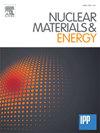OP2.1后Wendelstein 7-X第一壁组分的管内比色法
IF 2.3
2区 物理与天体物理
Q1 NUCLEAR SCIENCE & TECHNOLOGY
引用次数: 0
摘要
在Wendelstein 7-X (W7-X)的每个操作阶段(OP)中,比色法一直被用于估计第一壁板和分流靶元素上的沉积层分布。在OP2.1中,通过安装主动冷却的导流器并将材料从细粒石墨改为碳纤维增强复合材料,在等离子体壁相互作用研究和导流器性能方面取得了重大成果。这一升级能够实现长时间的等离子体放电,达到500秒,总注入能量为1.3 GJ。OP1.2a与OP1.2b之间的净平均沉积厚度增加了2.5倍,而OP1.2b与OP2.1之间没有显著变化。第一墙板上沉积层的沉积和侵蚀平衡可能在OP2.1中发生了变化。从引射靶元素表面温度较低、体等离子体杂质含量较低、溅射碳源位置不同等可能性的角度定性地讨论了主要原因。此外,在OP1.2a和OP2.1中可以看到明显的分流靶元素的比色模式,而在op12 b中看不到。然而,目前还不能确定石墨导流器表面反射率和光学性质的变化是由于侵蚀还是沉积造成的。本文章由计算机程序翻译,如有差异,请以英文原文为准。
In-vessel colorimetry of Wendelstein 7-X first wall components after OP2.1
Colorimetry has been continuously utilized for the estimation of deposition layer distribution on the first wall panels and divertor target elements in each Operation Phases (OP) of Wendelstein 7-X (W7-X). In OP2.1, significant achievements were made in plasma-wall interaction studies and divertor performance, completed by the installation of actively cooled divertors together with the change of material from fine grain graphite to Carbon Fiber-reinforced Composite. This upgrade enabled the achievement of long-duration plasma discharges, reaching up to 500 s with a total injected energy of 1.3 GJ. Compared to a factor of 2.5 increase in the net average deposition thickness between OP1.2a and 1.2b, no significant change was observed between OP1.2b and OP2.1. The balance of deposition and erosion of deposition layer on the first wall panels is presumably changed in OP2.1. The considerable reasons are discussed qualitatively from the point of possibilities such as lower surface temperature of the divertor target elements, lower impurity level of bulk plasmas, and difference of the location of sputtered carbon source. Moreover, the clear pattern of the colorimetry on the divertor target elements is seen in OP1.2a and OP2.1 not in OP1.2b. However, it is not currently conclusive whether changes in reflectivity and optical properties on the graphite divertor surface are due to erosion or deposition.
求助全文
通过发布文献求助,成功后即可免费获取论文全文。
去求助
来源期刊

Nuclear Materials and Energy
Materials Science-Materials Science (miscellaneous)
CiteScore
3.70
自引率
15.40%
发文量
175
审稿时长
20 weeks
期刊介绍:
The open-access journal Nuclear Materials and Energy is devoted to the growing field of research for material application in the production of nuclear energy. Nuclear Materials and Energy publishes original research articles of up to 6 pages in length.
 求助内容:
求助内容: 应助结果提醒方式:
应助结果提醒方式:


